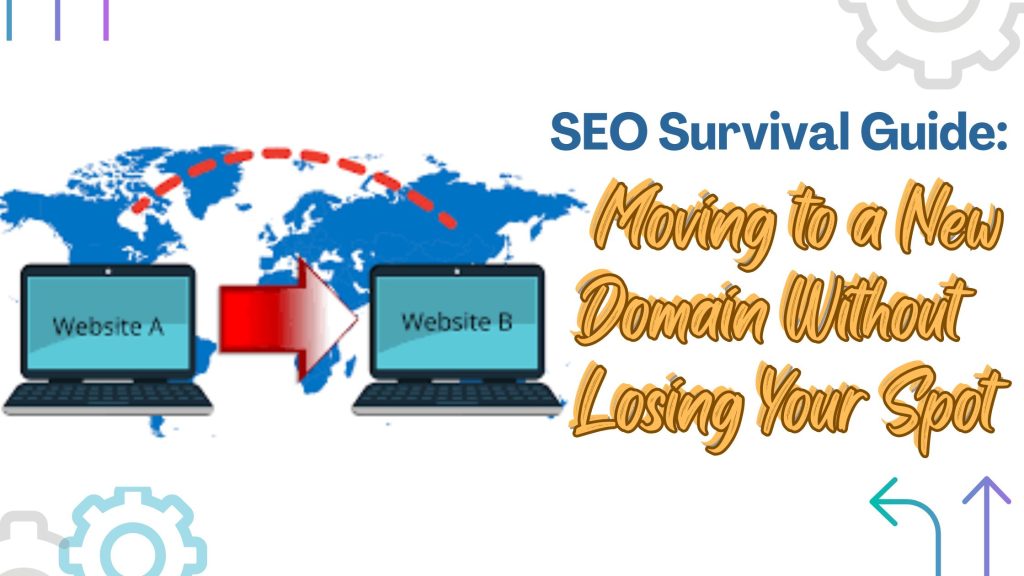Thinking about moving to a new domain? It can feel like a daunting task. After all, your website’s search engine rankings are on the line. But fear not! With the right strategies in place, you can navigate website migration smoothly and maintain your SEO standing.
Imagine embarking on a journey without a map. That’s how it feels when you’re unsure of how to execute a website migration effectively. You know that change is necessary, whether it’s due to rebranding or simply upgrading your online presence, but the stakes are high. A successful move requires careful planning and execution.
This SEO Survival Guide will walk you through everything you need to ensure that relocating to your new digital home doesn’t lead to losing valuable traffic or rankings. Ready for an adventure? Let’s dive into the essentials of maintaining SEO integrity while moving to a new domain!
The Importance of SEO in Website Migration
When it comes to website migration, SEO is your lifeline. Transitioning to a new domain can be beneficial, but without proper consideration for search engine optimization, you risk losing hard-earned visibility.
Search engines index websites based on various factors. A sudden change in your domain can send confusing signals if not managed correctly. This confusion often leads to drops in rankings and traffic.
SEO ensures that users still find you during and after the transition. By prioritizing it, you help preserve existing authority while fostering growth in new areas.
Moreover, maintaining SEO best practices throughout the migration process enhances user experience. A seamless transition keeps visitors engaged and lowers bounce rates—two vital components for ranking well post-move.
Reasons for Moving to a New Domain
There are many reasons why a business might consider moving to a new domain. One common motivation is brand restructuring. As companies grow, they often rebrand to better reflect their mission or target audience.
Another factor can be keyword optimization. A new domain name that includes relevant keywords can significantly improve search visibility and user engagement.
Technical issues may also prompt a move. If your current domain has been plagued by penalties or poor performance, starting fresh with a clean slate could be the best option.
Additionally, mergers and acquisitions frequently lead organizations to consolidate multiple websites into one authoritative domain.
Changing your niche focus or expanding product lines may necessitate a more fitting URL that resonates with both existing and potential customers. Each of these factors plays an important role in deciding whether it’s time for a change in your online identity.
Preparing for the Move: Steps to Take Beforehand
Preparing for a domain move is crucial. Start by creating a detailed plan outlining every step of the migration process. This ensures nothing gets overlooked.
Next, take inventory of your existing content. Identify which pages are performing well and need to be transferred intact. Knowing what works helps maintain rankings.
Then, back up your website completely. Store files, databases, and any essential information securely in case you need to revert changes later.
Check for technical issues on your current site too. Fixing errors now will help ensure a smoother transition when you migrate to the new domain.
Inform stakeholders about the upcoming change ahead of time. Keeping everyone in the loop can prevent confusion during the migration process and prepare users for what’s coming next.
Implementing 301 Redirects for SEO Success
When moving to a new domain, implementing 301 redirects is crucial. This tells search engines that your content has permanently moved. As a result, you preserve the SEO equity built up on your old domain.
Start by mapping out all URLs from your old site. Ensure that each page points directly to its corresponding new URL. This not only helps maintain rankings but also improves user experience.
Remember, patience is key after setting up these redirects. It may take time for search engines to recognize the changes and update their indexes accordingly.
Monitor traffic closely in the weeks following the migration. Look out for any unexpected drops or errors in crawling reports, as they can signal issues with redirect chains or broken links.
Test every redirect! A smooth transition relies on ensuring users land exactly where they need to go without frustration or confusion.
Updating Internal Links and URLs
After migrating to a new domain, updating internal links and URLs is crucial. This step helps maintain the flow of link equity throughout your site.
Start by auditing your content. Identify all instances where old URLs are linked within blog posts, pages, or navigation menus. A thorough scan ensures nothing falls through the cracks.
Next, replace outdated links with their new counterparts. It’s essential for user experience; broken links can frustrate visitors and increase bounce rates.
Don’t forget about images and other media that may also include URL references. Ensure every element reflects the new domain structure accurately.
Using tools like Screaming Frog or Google Search Console can simplify this process significantly. They help highlight any lingering issues so you can address them promptly before they affect your SEO performance. Every link counts in preserving those hard-earned rankings on search engines as well!
Informing Search Engines About the Website Migration
Once you’ve migrated to a new domain, informing search engines is crucial. This step ensures that your site’s visibility and rankings aren’t compromised.
Start by using Google Search Console. Add your new domain and verify ownership. This tool helps you communicate directly with Google about the changes you’ve made.
Submit a change of address in the Search Console settings. This action signals to Google that your site has moved. It’s an essential indicator for search engine crawlers.
Additionally, submit updated sitemaps for both domains. The sitemap acts as a roadmap, guiding search engines through your content on the new domain.
Don’t overlook Bing Webmaster Tools either; they have similar features for notifying them of your transition.
Taking these actions helps maintain traffic flow while safeguarding your SEO efforts during this transitional phase.
Monitoring and Troubleshooting Your Site’s Performance
Monitoring your site’s performance after migrating to a new domain is crucial. Use tools like Google Analytics and Search Console to track traffic patterns, bounce rates, and user engagement.
Look for any sudden drops in visitors. This can signal potential issues with redirects or indexing. Regularly check if all pages are loading correctly without errors.
Analyze search rankings for targeted keywords. Fluctuations might indicate that your SEO efforts need adjustment post-migration.
Set up alerts for significant changes in performance metrics. Quick responses can minimize negative impacts on your site’s visibility.
Don’t overlook page speed testing as well; slow load times can deter users and affect rankings too. Consider utilizing services like GTmetrix or Pingdom to ensure optimal speeds across the board.
Keep an eye on backlinks leading to your old domain, ensuring they redirect properly to maintain authority and relevance effectively.
Common Mistakes to Avoid During Website Migration
One common mistake is neglecting to plan the website migration thoroughly. Rushing can lead to oversights that jeopardize your SEO.
Failing to implement 301 redirects properly is another pitfall. These redirects guide both users and search engines from the old domain to the new one, preserving link equity.
Don’t overlook updating your sitemap and robots.txt file. If these files point to outdated URLs, search engines may struggle to index your site correctly.
Ignoring analytics tracking can also be detrimental. Ensure that all tracking codes are updated for the new domain so you can monitor performance accurately.
Don’t forget about communicating with stakeholders or customers about the change. Keeping everyone informed helps maintain trust during what could be a confusing transition.
Best Practices for Maintaining SEO Rankings on the New Domain
Transitioning to a new domain can feel daunting, but maintaining your SEO rankings is entirely achievable with the right strategies. Here are some best practices to ensure your site remains visible and competitive in search results.
First, stick to using 301 redirects for all pages from your old domain. This tells search engines that content has permanently moved, transferring authority and link equity effectively.
Next, update all internal links on your website. Ensure they point to the corresponding new URLs rather than the old ones. This helps users navigate smoothly while also signaling to search engines that you’ve made necessary changes.
It’s essential to keep an eye on analytics post-migration. Use tools like Google Analytics and Search Console to monitor traffic patterns and identify any significant drops or issues quickly.
Regularly check for crawl errors through Google Search Console as well. Address these promptly by fixing broken links or ensuring redirects function correctly.
Continue creating quality content that engages visitors even after migration. Fresh content keeps both users and search engines engaged with your site, which helps maintain rankings over time.
Reach out for backlinks from reputable sites within your niche again if possible. These connections will support building authority on the new domain while driving relevant traffic back toward it.
By following these best practices diligently during this transition phase, you’ll position yourself solidly in retaining valuable SEO performance throughout this exciting journey into a fresh online identity.

